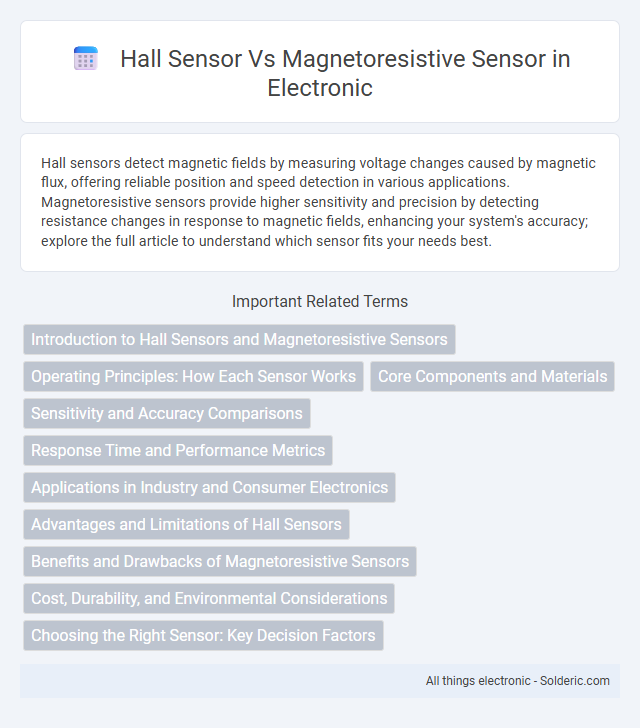Hall sensors detect magnetic fields by measuring voltage changes caused by magnetic flux, offering reliable position and speed detection in various applications. Magnetoresistive sensors provide higher sensitivity and precision by detecting resistance changes in response to magnetic fields, enhancing your system's accuracy; explore the full article to understand which sensor fits your needs best.
Comparison Table
| Feature | Hall Sensor | Magnetoresistive Sensor |
|---|---|---|
| Operating Principle | Measures voltage difference caused by magnetic field (Hall effect) | Detects change in electrical resistance due to magnetic field |
| Sensitivity | Moderate sensitivity to magnetic flux density | Higher sensitivity, detects weaker magnetic fields |
| Accuracy | Lower accuracy; noise can affect output | Higher accuracy; stable output over temperature variations |
| Temperature Range | -40degC to 85degC typical | -40degC to 150degC typical |
| Response Time | Fast, in microseconds | Very fast, nanoseconds range |
| Cost | Generally lower cost | Higher cost due to complex fabrication |
| Applications | Position sensing, current sensing, speed detection | Magnetic read heads, precise position sensing, automotive sensors |
Introduction to Hall Sensors and Magnetoresistive Sensors
Hall sensors utilize the Hall effect to detect magnetic fields by measuring the voltage generated perpendicular to the current flow in a conductive material. Magnetoresistive sensors operate based on the change in electrical resistance of a material when exposed to a magnetic field, often providing higher sensitivity and precision compared to Hall sensors. Both sensor types are widely employed in automotive, industrial, and consumer electronics for position, speed, and current sensing.
Operating Principles: How Each Sensor Works
Hall sensors detect magnetic fields based on the Hall effect, where a voltage is generated perpendicular to the current flow in a conductor exposed to a magnetic field. Magnetoresistive sensors operate by changing the electrical resistance of a ferromagnetic material when subjected to a magnetic field, enabling precise detection of magnetic flux variations. You can choose between these sensors depending on the required sensitivity and application, as Hall sensors are commonly used for simpler position sensing, while magnetoresistive sensors offer higher accuracy in detecting magnetic field changes.
Core Components and Materials
Hall sensors utilize a thin strip of semiconductor material, typically gallium arsenide or silicon, as the core component where the Hall effect generates a voltage proportional to the magnetic field. Magnetoresistive sensors rely on magnetic materials such as permalloy or spin-valve structures that change electrical resistance in response to an external magnetic field. The choice of these core components directly influences sensitivity, durability, and application suitability in magnetic field detection.
Sensitivity and Accuracy Comparisons
Magnetoresistive sensors exhibit higher sensitivity and greater accuracy compared to Hall sensors, making them ideal for detecting small magnetic field variations with precision. Hall sensors typically offer moderate sensitivity and are well-suited for applications requiring robustness rather than fine measurement detail. The intrinsic properties of magnetoresistive materials enable enhanced resolution in magnetic field detection, outperforming the linearity and range limitations often found in Hall sensor technology.
Response Time and Performance Metrics
Hall sensors typically exhibit faster response times, often in the microsecond range, making them suitable for real-time applications requiring rapid magnetic field detection. Magnetoresistive sensors offer higher sensitivity and better linearity, enhancing performance metrics such as signal-to-noise ratio and measurement accuracy, especially in low magnetic field environments. You should choose a sensor based on the specific demands for response speed versus precision in your application.
Applications in Industry and Consumer Electronics
Hall sensors excel in automotive speed detection, position sensing, and current monitoring due to their cost-effectiveness and reliability. Magnetoresistive sensors provide higher sensitivity and precision, making them ideal for hard disk drives, robotics, and navigation systems in consumer electronics. Both sensor types enable enhanced automation and improved device functionality in industrial and consumer applications.
Advantages and Limitations of Hall Sensors
Hall sensors offer advantages such as simple design, cost-effectiveness, and reliable performance in detecting magnetic fields with minimal power consumption. They provide good linearity and withstand harsh environments, making them suitable for automotive and industrial applications. However, Hall sensors have limitations in sensitivity and resolution compared to magnetoresistive sensors, which may affect precision in detecting weak or subtle magnetic variations critical to Your application.
Benefits and Drawbacks of Magnetoresistive Sensors
Magnetoresistive sensors offer higher sensitivity and better signal-to-noise ratio compared to Hall sensors, making them ideal for precise magnetic field detection and small magnetic signal measurements. They exhibit low power consumption and excellent temperature stability, enhancing performance in harsh environments. However, magnetoresistive sensors can be more expensive and complex to integrate, requiring careful calibration and additional signal processing compared to simpler Hall sensor designs.
Cost, Durability, and Environmental Considerations
Hall sensors typically offer lower cost and simpler construction compared to magnetoresistive sensors, making them suitable for budget-sensitive applications. Magnetoresistive sensors provide higher durability and improved sensitivity in harsh environments, with better resistance to temperature variations and electromagnetic interference. Environmental considerations favor magnetoresistive technology for long-term reliability in demanding industrial and automotive settings, while Hall sensors are often preferred in less extreme conditions due to their cost-effectiveness.
Choosing the Right Sensor: Key Decision Factors
Choosing the right sensor between Hall and magnetoresistive types depends on your application's sensitivity, accuracy, and environmental conditions. Hall sensors offer robustness and cost-effectiveness with moderate precision, ideal for general position and speed detection, while magnetoresistive sensors provide higher sensitivity and accuracy, suited for low magnetic field detection and complex magnetic environments. Understanding these key decision factors ensures optimal sensor performance tailored to your specific technical and operational requirements.
Hall sensor vs magnetoresistive sensor Infographic

 solderic.com
solderic.com